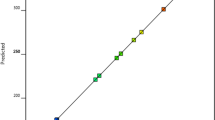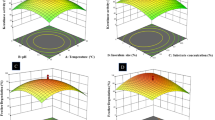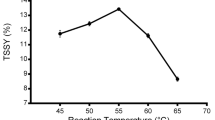Abstract
Statistical optimization of the biodegradation of two keratinous wastes directed by Bacillus subtilis recombinant cells was carried out by means of a response surface methodology. A Box–Behnken design was employed to predict the optimal levels of three variables namely, keratin percent, incubation time and inoculum size. Analysis of variance revealed that, only keratin percent had the highest significant effect. Canonical analysis and ridge max analysis were used to get the optimal levels of the three predictors along with the optimum levels of the responses. The optimal sets of predicted and validated levels of the three variables were [7.69% (w/v) feathers, 96.58 h and 1.28% (v/v) inoculum size] and [8% (w/v) feathers, 98.45 h, 3.9% (v/v) inoculum size] to achieve the highest levels of soluble proteins (1.25–1.7 mg/ml) and NH2-free amino groups (245.82–270.0 μmol leucine/ml), respectively upon using three optimized feathers-based media. These values represented 83.67–100% and 100% adequacy for the models of soluble proteins and NH2-free amino groups, respectively. While, [8.23% (w/v) sheep wool, 5.52% (v/v) inoculum size and 46.58 h] and [8.33% (w/v) sheep wool, 5.89% (v/v) inoculum size and 63.46 h] were the optimal sets of predicted and validated levels of the above variables to achieve the highest yields of soluble proteins (3.4–4.6 mg/ml) and NH2-free amino groups (290.9–302.0 μmol leucine/ml), respectively upon using three optimized sheep wool-based media. These values represented 100% adequacy for the models of soluble proteins and NH2-free amino groups. By the end of the optimization strategy, a fold enhancement (2.14–2.43 and 1.78–2.12) in the levels of released soluble proteins and NH2-free amino groups, respectively was obtained upon using three optimized feathers-based media. However, a fold enhancement (4.25–5.75 and 2.42–2.5) in the levels of soluble proteins and NH2-free amino groups, respectively was obtained upon using three optimized sheep wool-based media. Data would encourage pilot scale optimization of the biodegradation of these wastes.








Similar content being viewed by others
References
Adinarayana K, Ellaiah P (2002) Response surface optimization of the critical medium components for the production of alkaline protease by a newly isolated Bacillus sp. J Pharm Pharmceut Sci 5(3):272–278
Anbu P, Gopinath SCB, Hilda A, Lakshmipriya T, Annadurai G (2007) Optimization of extracellular keratinase production by poultry farm isolate Scopulariopsis brevicaulis. Bioresour Technol 98:1298–1303
Bernal C, Diaz I, Coello N (2006) Response surface methodology for the optimization of keratinase production in culture medium containing feathers produced by Kocuria rosea. Can J Microbiol 52:445–450
Bernhardt K, Schrempf H, Goebel W (1978) Bacteriocin and antibiotic resistance plasmids in Bacillus cereus and Bacillus subtilis. J Bacteriol 133:897–903
Böckle B, Galunsky B, Müller R (1995) Characterization of keratinolytic serine protease from Streptomyces pactum DSM 40530. Appl Environ Microbiol 61:3705–3710
Box GEP, Behnken DW (1960) Some new three level design for study of quantitative variables. Technometrics 2:455–475
Bradford MM (1976) A rapid and sensitive method for the quantitation of microgram quantities of protein utilizing the principle of protein-dye bindings. Anal Biochem 72:248–255
Cai C-gang, Lou B-gan, Zheng X-dong (2008) Keratinase production and keratinase degradation by a mutant strain of Bacillus subtilis. J. Zhejiang Univ Sci B 9(1):60–67
Cai C, Zheng X (2009) Medium characterization for keratinase production in hair substrate by a new Bacillus subtilis KD-N2 using response surface methodology. J Ind Microbiol Biotechnol 36(7):875–883
Cao ZJ, Zhang Q, Wei DK, Chen L, Wang XQ, Zhou MH (2009) Characterization of a novel Stenotrophomomnas isolate with high keratinase activity and purification of the enzyme. J Ind Microbiol Biotechnol 36(2):181–188
Chang YN, Huang JC, Lee CC, Shih IL, Tzeng YM (2002) Use of response surface methodology to optimize culture medium for production of lovastatin by Monascus ruber. Enzyme Microbiol Technol 30:889–894
Deivasigamani B, Alagappan KM (2008) Industrial application of keratinase and soluble proteins from feather keratins. J Environ Biol 29(6):933–936
Douglas CM (2001) Design and analysis experiments, 5th edn. Wiley, Arizona, USA
Draper NR (1963) Ridge analysis’ of response surfaces. Technometrics 5:469–479
El-Refai HA, AbdelNaby MA, Gaballa A, El-Araby MH, Abdel Fattah AF (2005) Improvement of the newly isolated Bacillus pumilus FH9 keratinolytic activity. Process Biochem 40:2325–2332
Gheshlaghi R, Scharer JM, Moo-Young M, Douglas PL (2005) Medium optimization for the hen egg white lysozyme production by recombinant Aspergillus niger using statistical methods. Biotechnol Bioeng 90(6):754–760
Gokhade DV, Patil SG, Batawde KB (1991) Optimization of cellulose production by Aspergillus niger NCIM. Appl Biochem Biotechnol 30(2):99–109
Gousterova A, Braikova D, Geshov I, Christov P, Tishinov K, Tonkova TE, Haertle T, Nedkov P (2005) Degradation of keratin and collagen wastes by newly isolated Thermoactinomycetes or by alkaline hydrolysis. Lett Appl Microbiol 40:335–340
Grazziotin A, Pimentel FA, Sangali S, de Jong EV, Brandelli A (2006) Nutritional improvement of feather protein by treatment with microbial keratinases. Animal Feed Sci Technol 126:135–144
Grazziotin A, Pimentel FA, Sangali S, de Jong EV, Brandelli A (2007) Production of feather protein hydrolysate by keratinolytic bacterium Vibrio sp.kr2. Bioresour Technol 98:3172–3175
Gupta R, Rammani P (2006) Microbial keratinases and their prospective applications: an overview. Appl Microbiol Biotechnol 70:21–33
Heck JX, De Barros S, Ayub M (2005) Optimization of xylanase and mannanase production by Bacillus circulans strain BL53 on solid state cultivation. Enzyme Microb Technol 37:417–423
Hoerl AE (1959) Optimum solution of many variables equations. Chem Eng Prog 55:67–78
Jain Z, Nian-fa G (2007) Application of response surface methodology in medium optimization for pyruvic acid production of Torulopsis glabrata TP19 in batch fermentation. J Zhejiang Univ Sci B 8(2):98–104
Kalil SJ, Maugeri F, Roderigues MI (2000) Response surface analysis and simulation as a tool for bioprocess design and optimization. Process Biochem 35:539–550
Khardenavis AA, Kapley A, Purohit HJ (2009) Processing of poultry feathers by alkaline keratin hydrolyzing enzyme from Serratia sp. HPC 1383. Waste Manag 29:1409–1415
Kim JM, Lim WJ, Suh HJ (2001) Feather-degrading Bacillus species from poultry waste. Process Biochem 37:287–291
Kluskens LD, Voorhorst WGG, Siezen RJ, Schwerdtfeger RM, Antranikian G, van der Oost J, de Vos WM (2002) Molecular characterization of fervidolysin, a subtilisin-like serine protease from the thermophilic bacterium Fervidobacterium pennavorans. Extermophiles 6:185–194
Lin X, Kelemen DW, Miller ES, Shih JCH (1995) Nucleotide sequence and expression of ker A; the gene encoding for a keratinolytic protease of Bacillus licheniformis PWD-1. Appl Environ Microbiol 61:1469–1474
Lin HH, Yin LJ, Jiang ST (2009a) Cloning, expression and purification of Pseudomonas aeruginosa keratinase in Escherichia coli AD949 (DE3) pLys S expression system. J Agric Food Chem 57(9):3506–3511
Lin HH, Yin LJ, Jiang ST (2009b) Expression and purification of Pseudomonas aeruginosa keratinase in Bacillus subtilis DB104 expression system. J Agric Food Chem 57(17):7779–7784
Lohomme B, Roux JC (1991) Utilization of experimental design for optimization of Rhizopus arrhizus culture. Bioresour Technol 35(3):301–312
Ionata E, Canganrella F, Bianconi G, Benno Y, Sakamoto M, Capasso A, Rossi M, La Cara F (2008) A novel keratinase from Clostridium sporogenes bv Pennavorans from solfataric muds. Microbiol Res 163:105–112
Mitsuiki S, Ichikawa M, Oka T, Sakai M, Moriyama Y, Sameshima Y, Goto M, Furukawa K (2004) Molecular characterization of a keratinolytic enzyme from an alkalophilc Nocardiopsis sp. TOA-1. Enzyme Microb Technol 34:482–489
Myers RH (1976) Response surface methodology. Edwards Brothers, Ann Arbor, MI
Nam GW, Lee DW, Lee HS, Lee NJ, Kim BC, Choe EA, Hwang JK, Suhartono MT, Pyum YR (2002) Native-feather degradation by Fervidobacterium islandicum AW-1, a newly isolated keratinase-producing thermophilic anaerobe. Arch Microbiol 178:538–547
Onifade AA, Al-Sane NA, Al-Mussalam AA, Al-Zarban S (1998) A review: potentials for biotechnological applications of keratin-degrading microorganisms and their enzymes for nutritional improvement of feathers and other keratins as livestock feed resources. Bioresour Technol 66:1–11
Oulad Haddar H, Zaghloul TI, Saeed HM (2009) Biodegradation of native feather keratin by Bacillus subtilis recombinant strains. Biodegradation 20:687–694
Pearce KN, Karahalios D, Friedman M (1988) Ninhydrin assay for proteolysis in ripening cheese. J Food Sci 53(2):432–435
Prakash P, Jayalakshmi SK, Sreeramulu K (2010) Production of keratinase by free and immobilized cells of Bacillus halodurans strain PPKS-2: partial characterization and its application in feather degradation and dehairing of the goat skin. Appl Biochem Biotechnol 160(7):1909–1920
Radha S, Gunasekaran P (2008) Sustained expression of keratinase gene under PxylA and Pamyl promoters in the recombinant Bacillus megaterium MS 941. Bioresour Technol 99:5528–5537
R Development Core Team (2009). R: a language and environment for statistical computing. R Foundation for Statistical Computing, Vienna, Austria. ISBN 3-900051-07-0, http://www.R-project.org/
Rucka M, Lamer-Zarawska E, Maliszewska I, Turkiewicz B (1998) Optimization of growth and hydrolytic enzymes production by Fusarium culmorum using response surface methodology. Bioprocess Eng 19:229–232
Sangali S, Brandelli A (2000) Feather keratin hydrolysis by a Vibrio sp. strain kr2. J Appl Microbiol 89:735–743
Santos RMDB, Firmino AAP, de Sa CM, Felix CR (1996) Keratinolytic activity of Aspergillus fumigatus Fresenius. Curr Microbiol 33:364–370
Sharma A, Bardhan D, Patel R (2009) Optimization of physical parameters for lipase production from Arthrobacter sp. BGCC#490. Ind J Biochem Biophys 46(2):178–183
Syed DG, Lee JC, Li WJ, Kim CJ, Agasar D (2009) Production, characterization and application of keratinase from Streptomyces gulbargensis. Bioresour Technol 100:1868–1871
Wang JJ, Swaisgood HE, Shih JCH (2003) Bioimobilization of keratinase using Bacillus subtilis and Escherichia coli systems. Biotechnol Bioeng 81:21–429
Williams CM, Richter CS, MacKenzie JM, Shih JCH (1990) Isolation, identification, and characterization of a feather degrading bacterium. Appl Environ Microbiol 56:1509–1515
Xie F, Chao Y, Yang X, Yang J, Xue Z, Luo Y, Qian S (2010) Purification and characterization of four keratinases produced by Streptomyces sp. strain 16 in native human foot skin medium. Biores Technol 101(1):344–500
Zaghloul TI, Abdelaziz A, Moustafa MH (1994) High level of expression and stability of the cloned alkaline protease (aprA) gene in Bacillus subtilis. Enzyme Microbiol Technol 16:534–537
Zhang J, Marcin C, Shifflet MA, Salmon P, Brix T, Greasham R, Boukland B, Chartrain M (1996) Development of fermentation process for physotigmine production by Streptomyces griseofuscus. Appl Microbiol Biotechnol 44(5):568–575
Acknowledgements
The authors are very grateful to Chemist/Heba-Allah S. Marey, Assistant lecturer of the Institute of Graduate Studies and Research (IGSR), Environmental Studies Department, Alexandria University, Egypt and Dr. Nadia A. Soliman, Assistant professor of Mubarak City for Scientific Research and Technology, Bioprocess Department, Alexandria, Egypt for their great help concerning modeling.
Author information
Authors and Affiliations
Corresponding author
Rights and permissions
About this article
Cite this article
Embaby, A.M., Zaghloul, T.I. & Elmahdy, A.R. Optimizing the biodegradation of two keratinous wastes through a Bacillus subtilis recombinant strain using a response surface methodology. Biodegradation 21, 1077–1092 (2010). https://doi.org/10.1007/s10532-010-9368-6
Received:
Accepted:
Published:
Issue Date:
DOI: https://doi.org/10.1007/s10532-010-9368-6




